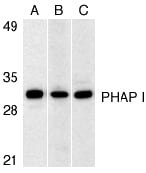Anti-PHAP1 antibody (ab5991)
Key features and details
- Rabbit polyclonal to PHAP1
- Suitable for: WB, ICC/IF, IHC-P
- Reacts with: Mouse, Rat, Human
- Isotype: IgG
Overview
-
Product name
Anti-PHAP1 antibody
See all PHAP1 primary antibodies -
Description
Rabbit polyclonal to PHAP1 -
Host species
Rabbit -
Specificity
This antibody does not cross react with PHAP12a or PHAPIII isoforms. -
Tested applications
Suitable for: WB, ICC/IF, IHC-Pmore details -
Species reactivity
Reacts with: Mouse, Rat, Human -
Immunogen
Synthetic peptide within Human PHAP1 aa 199-249 (C terminal). The exact sequence is proprietary. A peptide corresponding to 14 amino acids near the carboxy terminus of human PHAP1.
(Peptide available asab6240)
Properties
-
Form
Liquid -
Storage instructions
Shipped at 4°C. Store at +4°C short term (1-2 weeks). Upon delivery aliquot. Store at -20°C long term. Avoid freeze / thaw cycle. Stable for 12 months at -20°C. -
Storage buffer
pH: 7.2
Preservative: 0.02% Sodium azide
Constituent: PBS -
 Concentration information loading...
Concentration information loading... -
Purity
Immunogen affinity purified -
Primary antibody notes
Apoptosis is related to many diseases and development. Caspase-9 plays a central role in cell death induced by a variety of apoptosis activators. Cytochrome c, after released from mitochondria, binds to Apaf-1, which forms an apoptosome that in turn binds to and activate procaspase-9. Activated caspase-9 cleaves and activates the effector caspases (caspase-3, -6 and –7), which are responsible for the proteolytic cleavage of many key proteins in apoptosis. The tumor suppressor putative HLA-DR-associated proteins (PHAPs) were recently identified as important regulators of mitochondrion apoptosis. PHAP appears to facilitate apoptosome-mediated caspase-9 activation and to stimulate the mitochondrial apoptotic pathway. PHAP was also shown to oppose both Ras- and Myc-mediated cell transformation. -
Clonality
Polyclonal -
Isotype
IgG -
Research areas
Images
-
All lanes : Anti-PHAP1 antibody (ab5991) at 1 µg/ml
Lane 1 : 293 cell lysate
Lane 2 : A431 cell lysate
Lane 3 : A549 cell lysate
Lane 4 : CaCo-2 cell lysate
Lane 5 : Daudi cell lysate
Lane 6 : HeLa cell lysate
Lane 7 : HepG2 cell lysate
Lane 8 : K562 cell lysate
Lane 9 : MCF-7 cell lysate
Lane 10 : Jurkat cell lysate
Lane 11 : SK-N-SH cell lysate
Lane 12 : THP-1 cell lysate
Lane 13 : NIH/3T3 cell lysate
Lane 14 : YB2/0 cell lysate
Lysates/proteins at 15 µg per lane.
Secondary
All lanes : HRP-conjugated goat anti-rabbit IgG at 1/10000 dilutionIncubated with the primary antibody for 1 hour at room temperature in 5% NFDM/TBST.
-
ab5991 at 2µg/ml staining PHAP1 in mouse small intestine tissue by IHC
-
All lanes : Anti-PHAP1 antibody (ab5991) at 1 µg/ml
Lane 1 : Mouse heart tissue lysate
Lane 2 : Mouse pancreas tissue lysate
Lane 3 : Mouse testis tissue lysate
Lane 4 : Mouse liver tissue lysate
Lane 5 : Mouse spleen tissue lysate
Lane 6 : Mouse kidney tissue lysate
Lane 7 : Mouse colon tissue lysate
Lane 8 : Mouse stomach tissue lysate
Lane 9 : Mouse brain tissue lysate
Lane 10 : Mouse skin tissue lysate
Lane 11 : Mouse skeletal muscle tissue lysate
Lane 12 : Mouse bladder tissue lysate
Lane 13 : Mouse lung tissue lysate
Lane 14 : K562 cell lysate
Lysates/proteins at 15 µg/ml per lane.
Secondary
All lanes : HRP-conjugated goat anti-rabbit IgG at 1/10000 dilutionIncubated with the primary antibody for 1 hour at room temperature in 5% NFDM/TBST.
-
Western blot analysis of PHAP I expression in human Raji cell (A), mouse (B) and rat (C) testis tissue llysates with anti-PHAP I at 1 µg/ml.
-
Immunofluorescence of PHAP I in mouse small intestine cells using ab5991 at 20µg/ml.



















